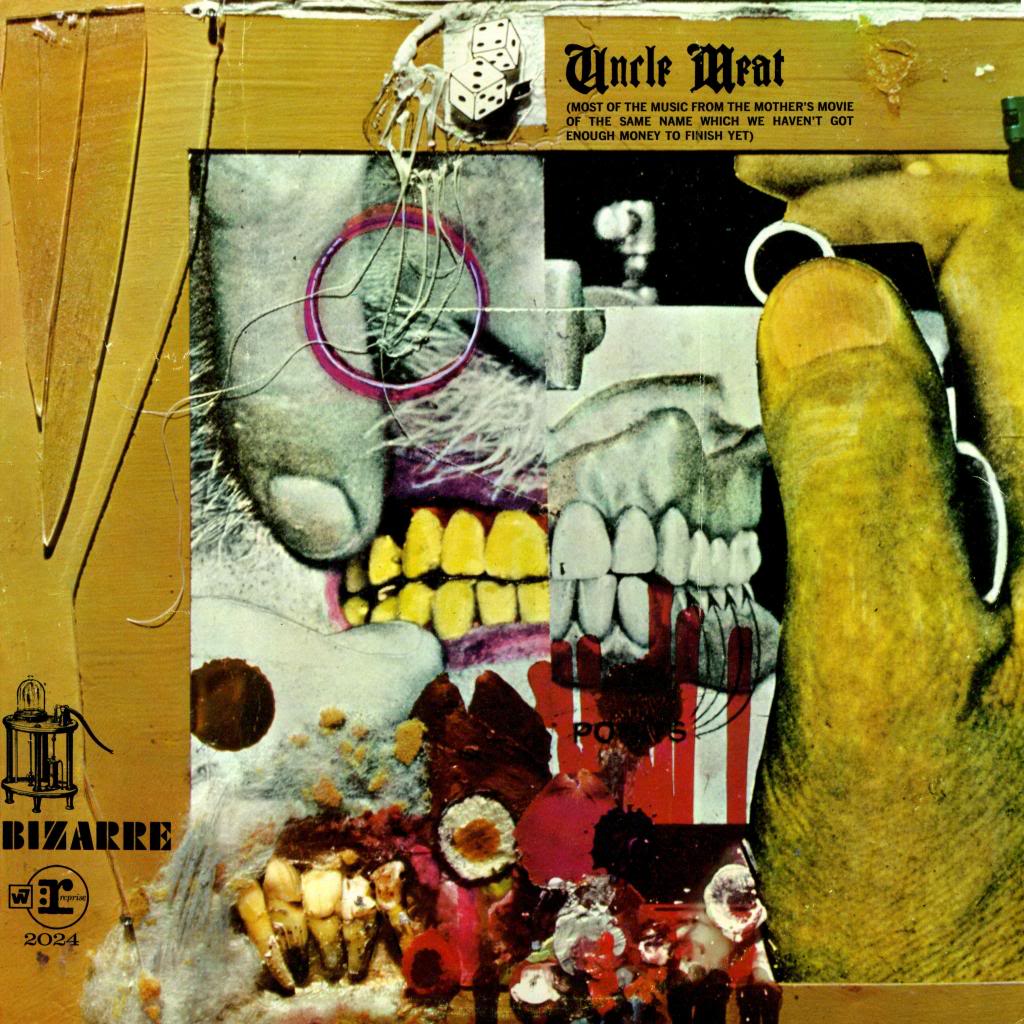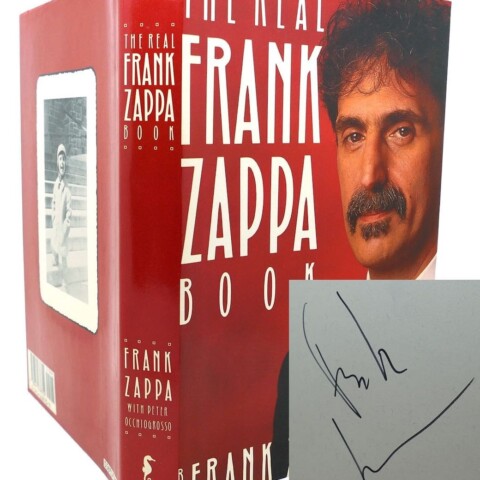With Universal reissuing remastered versions of Frank Zappa’s enormous catalogue, Gary Steel takes up the challenge of reviewing all of FZ’s genius album creations, one by one, and giving them a unique ‘Zappa Rating’. Today’s selection: Uncle Meat.
Frank Zappa – Uncle Meat (Zappa Records/Universal) #6
 WHEN I TOOK on the gargantuan task of reviewing each and every one of Universal’s 70-odd Frank Zappa album reissues, I hadn’t anticipated coming to an abrupt, clunking dead-stop at album number six, Uncle Meat.
WHEN I TOOK on the gargantuan task of reviewing each and every one of Universal’s 70-odd Frank Zappa album reissues, I hadn’t anticipated coming to an abrupt, clunking dead-stop at album number six, Uncle Meat.
The thing is, it’s one of the most extraordinary records released in the 1960s, and it’s probably my favourite Zappa album, but it’s also a devil of a thing to write about, because its sonic signature is so distinctive and so ineluctably alien, and it’s really not even a rock album, in the conventional use of the word.
Although Uncle Meat is easy enough to sit through, it takes multiple plays to even begin to come to terms with it, and to process its irreducible complexity.
Unlike Freak Out! and We’re Only In It For The Money, Uncle Meat was never going to trouble even the margins of the mainstream, and its experimentalism would mean that, for decades, it was difficult to assess its importance within any specific context, but musically, it would go on to define a whole genre that sprang up in the UK and Europe in the early ‘70s – that of art rock groups like Henry Cow, The Art Bears and Universe Zero, the “rock in opposition” movement of the late ‘70s, and the aesthetic home to those bands, the Recommended label.
Still, while it’s hard to listen to Henry Cow’s terrific debut album, Leg-end, without thinking of Uncle Meat, Zappa’s album is one amongst several in his artistic lifetime that can truly be named as a genre-unto-itself, and still sounds utterly unique 44 years later.
 Supposedly the soundtrack to a movie that was never made (a re-edited videotape approximation was finally released in the late ‘80s, but has never made it to DVD), in fact it’s a stand-alone audio project that originally sprawled over four sides of luscious vinyl.
Supposedly the soundtrack to a movie that was never made (a re-edited videotape approximation was finally released in the late ‘80s, but has never made it to DVD), in fact it’s a stand-alone audio project that originally sprawled over four sides of luscious vinyl.
The first thing that hits you is Cal Schenkel’s bizarre cover, a graphic collage of hands, skull and teeth that must have been shocking in 1969, and anticipates the imagery of the industrial scene of the late ‘70s (Throbbing Gristle, SPK, Cabaret Voltaire…) It was the beginning of a run of Schenkel artworks for Zappa albums that would provide an imaginative visual foil for the equally shocking music and ideas within.
Collage would prove to be a major element of Zappa’s music on Uncle Meat, too, and this album is the next step along in this respect from the hundreds of meticulously edited, sliced and diced sections on We’re Only In It For The Money. Except he goes much further: at its most extreme, Uncle Meat is an experiment in tape manipulation, with whole sections/compositions of spooky sped up/slowed down/re-constituted instruments. For anyone freaked out by rampant experimentation, however, there’s always a song or a vocal track not too far away, and therein lies its brilliance. While Uncle Meat is one of the strangest albums ever released, its experiments in sound are at first the tracks you tend to skip over or not engage with, in preference to tracks with melodic content or lyrics. But as you get familiar with the album, the more far-out tracks start to sound like a far-off galaxy that you might just want to explore. Ultimately, they become your favourites.
There’s very little actual rock on Uncle Meat, with the experimental tracks veering closer to the rarefied world of academic electronic composition, and the songs coming across as something between mutant doo-wop and greasy rock’n’roll. And then there’s the jazz, but we’ll get to that later.
This review would be a book if I wrote about every single track, so I’ll try to cherry-pick some highlights, along with pieces that illustrate the key elements Zappa was interrogating on this album.
Recorded from late 1967 through to February 1968 (but not released until early 1969), Uncle Meat is partly about the new recording technology that was then becoming available: it was recorded on a prototype 12-track desk, which allowed Zappa to layer up to 40 times, and it’s clear that he made full use of this new development.
 The short title theme sets up the main elements, with prominent harpsichord used as a rhythm anchor and key-changer rather than a lead instrument, and orbiting around that are metrically precise clusters of xylophones and sped-up horn instruments. Here, and elsewhere, the harpsichord and xylophone sometimes wears the melodic pants, allowing the ‘horns’ (and because they’re manipulated we seldom hear a recognisable horn sound) to provide flavour, texture and shading. Often on this album, the xylophone is used as a percussion instrument to lend a hand to the smattering of similarly precise drum effects. These may be the main elements, but they’re by no means the only instruments or techniques used. They do, however, make for a sound that is unlike that of any other record.
The short title theme sets up the main elements, with prominent harpsichord used as a rhythm anchor and key-changer rather than a lead instrument, and orbiting around that are metrically precise clusters of xylophones and sped-up horn instruments. Here, and elsewhere, the harpsichord and xylophone sometimes wears the melodic pants, allowing the ‘horns’ (and because they’re manipulated we seldom hear a recognisable horn sound) to provide flavour, texture and shading. Often on this album, the xylophone is used as a percussion instrument to lend a hand to the smattering of similarly precise drum effects. These may be the main elements, but they’re by no means the only instruments or techniques used. They do, however, make for a sound that is unlike that of any other record.
But we’re only 1:55 into the album when it’s interrupted by an insane 26 seconds of dialogue by a very jaded Suzy Creamcheese (remember her?) who does a very naughty thing and uses the word ‘fuck’. Later, there’s another monologue called ‘Our Bizarre Relationship’ that again shows how Zappa was always testing the limits of what the censorship laws would allow at the time, as well as putting the rock lifestyle itself in the spotlight by including audio verite-style segments where band members talk about groupies or how unhappy they are with what they’re being paid by that bad employer guy, Zappa. Not only that, but they have value as being almost-real social-anthropological documentations of an actual scene, and it’s an approach that he would continue to take throughout his life.
‘Nine Types Of Industrial Pollution’ (a title that, like so many, is uniquely Zappa) is a six minute guitar extemporisation in which he takes a pointed comment at those who play it fast just to show how clever they are, and the so-called ‘authenticity’ of music performed in realtime: it’s a sped-up guitar solo against a background of preternaturally busy, dive-bombing and skittering percussion effects. In the lexicon of popular music, there had never been anything like it.
[As a footnote, it was probably Henry Cow guitarist Fred Frith’s effusive essay on this piece in New Musical Express in the early ‘70s that convinced me I must check out this Zappa fellow].
‘Zolar Czakl’ is a mere 54 seconds of ‘impossible’ wind instruments (Clarinets? Oboes? Who knows!) and odd wheezing sounds that could almost have come off the Beach Boys’ off-the-wall Smiley Smile album.
But everything so far seems like a prequel to ‘Dog Breath, In The Year Of The Plague’, which in 3:58 manages to traverse whole worlds, and create a few more. Suddenly, we’re hit with the vast difference between the rude sax and guttural wordless doo-wop vocal sounds, and the arty aroma of the first few tracks. There’s a chorus of voices sped-up to sound like chipmunks, and semi-nonsense lyrics: “Fuzzy dice/Bongos in the back/My ship of love/Ready to attack.” It’s an example of Zappa’s brilliant way with words, in this case creating a period scenario with a great economy of means. There’s a female opera singer somewhere in the mix, and a really brief but unbelievably cool few bars of strange, off-the-wall experiment. High culture/low culture, all wrapped in one convenient package, which begins with a snort and ends with a snore, and never fails to simultaneously intrigue and amuse.
‘The Legend Of The Golden Arches’ contrasts the previous garish humour with a gorgeous sound that fuses elements of modern classical with jazz, skittering percussion effects and ends like a lullaby. Heck, there’s even a flute.
Two minutes and 19 seconds is long enough for the distortion-laden live recording of ‘Louie Louie’ at the Royal Albert Hall in London, replete with “the majestic pipe organ”, sax squeals and audience laughter. It’s more punk than punk.
Zappa’s crazy compositional style is fully in place on ‘The Dog Breath Variations’, 1:48 of his seemingly insane, but in fact perfectly proportioned, highly disciplined technique; and it’s a signature style that would pop up again on much more commercial, rock oriented tracks like 1974’s ‘Nanook Rubs It’ (Apostrophe).
Surreal is the word for ‘Sleeping In A Jar’, a song that is much better than its brief 50 seconds would seem to indicate. “It’s the middle of the night/And your mom and dad are sleeping/Sleeping in a jar/(The jar is under the bed).” This is Zappa bringing out that part of his character that was b-grade horror/Roald Dhal gothic horror stories for children/Salvador Dali with a guitar.
‘Uncle Meat Variations’ is more good clean fun: All of the key elements are here, including the mad xylophones, the harpsichord triplets, the sped-up wind instruments/horns/whatever, and then… a female operatic voice intoning nutty lyrical variations on previous themes, and even a short “rocking out” section in miniature. Just great.
But what I can’t really articulate is the way Zappa composes around dizzying time changes, and the way the various instruments playing across the rhythms really fires up the mental neurons – it’s like the composer has had enough caffeine and tobacco to achieve lift-off, and he’s replicating the sheer physicality of the intellectual reaction of the experience, in music.
‘Electric Aunt Jemima’ is a jaunty little ditty with a hint of doo-wop, more chipmunks and backwards voices and lyrics like: “Tried to find a reason/Not to quit my job/Beat me till I’m hungry/Found a punk to rob…” and “Tried to find a raisin/Brownies in the basin/Monza by the street light/Aunt Jemima all night/Holiday and salad days/And days of mouldy mayonnaise/Caress me (ah!)/Caress me Aunt Jemima.”
Anyway. ‘Prelude To King Kong’ is a raw, crazy saxophone improv, followed by a sarcastic live rendition of ‘God Save America’ and ‘A Pound For A Brown On The Bus’, 1:29 of chirruping woodwinds and intense overdubbery.
‘Ian Underwood Whips It Out’ is another chance for the saxophonist to blurt it all out live on stage, except it isn’t quite that. It is, in fact, possibly the first example of the cutting techniques Zappa would use extensively later on, where a track would one minute be a precise studio concoction, and the next would have a live solo grafted over the top.
It doesn’t let up from here on in. ‘Mr Green Genes’ is another sinister/surreal lyric that starts: “Eat your greens/Don’t forget your beans and celery…” but by the end has devolved to: “Eat your shoes/Don’t forget the strings/And sox/Even the box/You bought ‘em in/You can eat the truck/That brought ‘em in…/Eat the truck and driver/And his gloves/NUTRITIOUSNESS/DELICIOUSNESS/WORTHLESSNESS!” It’s a wonderfully twisted piece that seems to be taking aim not just at authority figures who tell us what to do, but those who convince us what to consume, together with a killing conclusion about the pointlessness of it all. This rather lovely tune would be repurposed as an instrumental on Zappa’s jazz fusion Hot Rats album.
 ‘We Can Shoot You’ is the second oddest track on the album, a brilliant exposition of Zappa’s talents at overdubbing, editing and tape manipulation, all in aid of composition.
‘We Can Shoot You’ is the second oddest track on the album, a brilliant exposition of Zappa’s talents at overdubbing, editing and tape manipulation, all in aid of composition.
‘The Air’ is a kind of inverted doo-wop track with chipmunk voices (as well as normal ones) and more surreal/scathing lyrics, but it seems rather minor next to ‘Project X’, the strangest track on the album. Like that experimental Beatles track, ‘Revolution Number 9’, in the rock context it’s really radical, but when compared to the work sonic scientists like Karlheinz Stockhausen were producing in their secret labs in Germany, it’s much less radical. Still, context is important, and ‘Project X’ is probably one of the most successful experimental tracks ever undertaken by a rock artist signed to a major label. More importantly, it works as a piece of music, going through a variety of moods and settings but mostly coming across as a bit spooked and surprisingly devoid of the usual comical tics. I never get sick of it.
‘Cruising For Burgers’ is another vocal track, and both its tune and singing make it sound like a discard from We’re Only In It For The Money. Except that it’s packed with strange and intriguing instrumentation, including what sounds like tympani, changing musical scenery and tricky time sequences. Oh, and more of those surreal lyrics.
The big finale is the side-long (on vinyl) ‘King Kong’ parts one to six, and this is Zappa and the Mothers in jazz/rock fusion mode, both live and in studio, and it makes this question rather inevitable: Why is it that Miles Davis gets so much kudos for his “electric period” jazz/rock fusion, when Zappa got there first, and had just as much (if not more) to say with the medium? Answers on a postcard, please.
‘King Kong’ is a monster, and a huge, mean riff that’s used for a variety of modal explorations by the band, and although it’s not consistently riveting all the way through, its best moments make it a classic of the then-nascent genre.
Uncle Meat is impossible to review, really, because there’s just too much going on here, and so little of it is stereotypical of any genre. It’s simply one of the greatest albums ever released, and one of the most exploratory, and it remains worthy of intense (and repeated) attention.
 The new Universal remaster clarifies the sound a little, but disappointingly uses Zappa’s 1993 master, and repeats the mistake of the original CD issue of the album, which is to have disc two start with over 40 minutes of meaningless and obscure dialogue from the movie, and even include a musical snippet recorded in the 1980s that seems to have no connection to the project whatsoever.
The new Universal remaster clarifies the sound a little, but disappointingly uses Zappa’s 1993 master, and repeats the mistake of the original CD issue of the album, which is to have disc two start with over 40 minutes of meaningless and obscure dialogue from the movie, and even include a musical snippet recorded in the 1980s that seems to have no connection to the project whatsoever.
What this means is that the listener needs to listen to disc one, then scroll down to track 4 on the second disc to hear the last track, ‘King Kong’. It’s a real pity they didn’t fix this to make it a seamless experience in the original running order, but at least the album’s available, and it’s sounding good. GARY STEEL
Sound = 3.5/5
Music = 5/5
Zappa Rating
Music = 5/5
Sound = 4/5
Recommendation: There are sonic improvements here, but if you’ve got the Ryko version, there’s really not much point in running out and spending the money again.
















The best review of Zappa’s “Uncle Meat” I’ve ever read. This album should be required listening in music appreciation classes examining the 20th century. By the way, I never thought of the influence on Henry Cow…totally makes sense. Thanks for reviewing all of these Zappa remasters, I look forward to reading your future posts!
Thanks for reviewing all of these Zappa remasters, I look forward to reading your future posts!
Thanks Mr Pahler (Gary, I presume?) Those are very kind words, and appreciated!
I agree with G Pahler. Great review! One of my favourite albums (in fact, the entire MOI cathalog is sick).
Keep rockin’ dude!